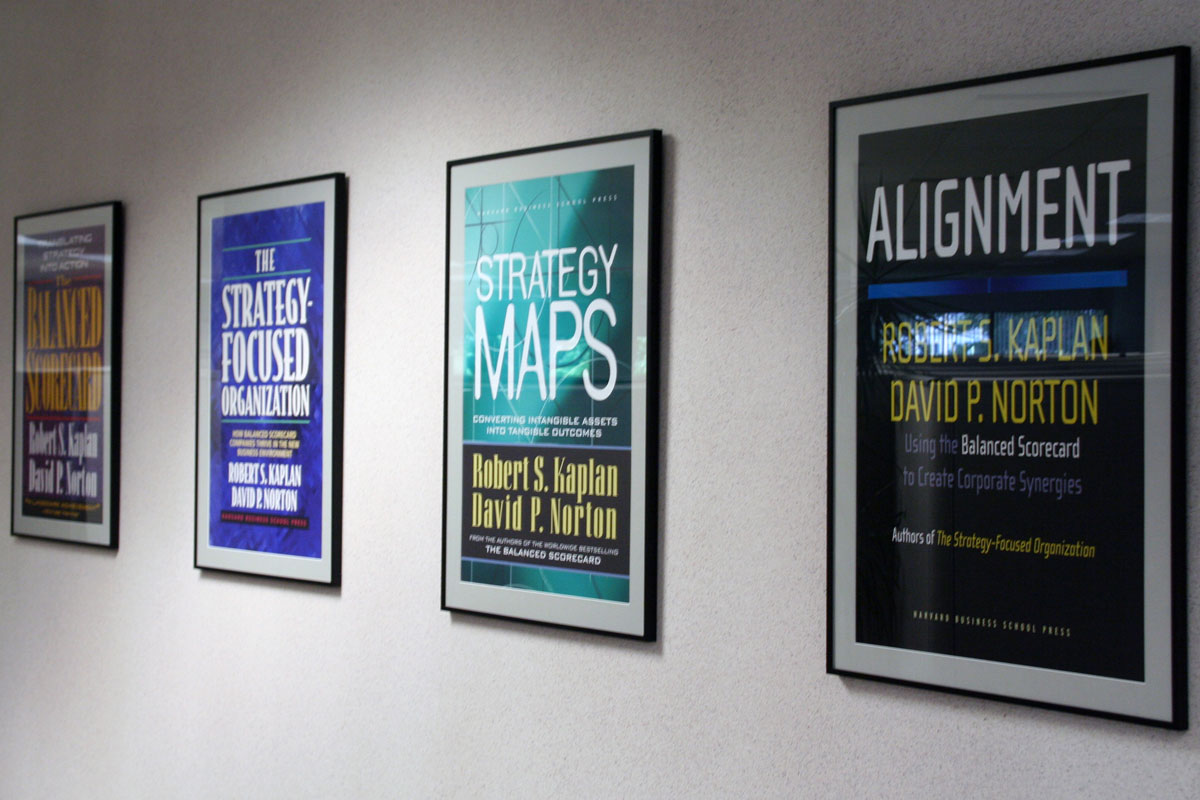Based on a study by the Harvard School of Economics in 1990, the idea of a strategy-oriented organization expanded into the Balanced Scorecard and got a simple and memorable acronym BSC. And although many companies all over the world apply this idea in one form or another, and those who have achieved the greatest success in this field get into the Hall of Fame and get a crystal symbol of belonging to the best practices, in Russia, the application of this concept does not always lead to the expected results.
According to David Norton and Robert Kaplan, the BSC is only one of the tools for a strategy-centric organization, though a key one. It is on the basis of this tool that Balanced Scorecard Collaborative (BSCol, today Palladium Group) was established to help companies around the world with their strategic management efforts.
Books can help to trace back the evolution of the Balanced Scorecard as a core into a “strategy-oriented organization”. Two Harvard professors have developed practical strategic management tools based on management feedback integrated into the elegant Balanced Scorecard information panel. To be more precise, they have developed practical tools for strategy execution. BSC is, in fact, the central link of this concept, the point where consolidated information about the company’s activity and movement converges. The set of indicators distributed among different aspects of activity (perspectives) helps to control the progress of strategy execution.

Balanced Scorecard Is the Core of Strategic Management
The very idea of a “strategy-oriented organization” is supported by a set of interlinked tools. These include, for example, strategic maps, the strategic office, the indicator set itself (BSC), etc. These tools, if not treated as simple attributes, help manage a company strategically. Quite often, in Russia and the CIS, companies that seek to build management based on a concept do not give them due importance, except for the indicator table itself. Despite the fact that in order to build a good strategic management system one should base it on the idea of “strategy-oriented organization”, many companies simplify their efforts to an “Implementation of BSC”.
It is not in vain that there is a saying: As you name the boat, so shall it float. Apart from the tendency to simplify, the use of Norton and Kaplan’s concept in the post-Soviet area is influenced by a number of specific peculiarities. The most characteristic features of an implementation of the idea of “strategically oriented organization” in Russia and CIS are the following:
- Weak training of management and executives. BSC, like many other concepts developed in the western world, based on the fundamental foundations of a free market economy: perfect competition, open capital markets, transparency of companies, etc. The history of the modern market economy in Russia lasted not even for two decades. The absence of a good modern (not planned!) economic school and little experience of activities in the new environment make an implementation of “unadapted”, pure BSC quite a challenge. The sets of indicators that I have seen in companies with BSC are either overly “sovietish” or copy-and-paste from Western examples. Both do not help much in real management.
- Cultural specifics. The employees’ disbelief in long-term and abstract, as a rule, indicators, as well as their disbelief in the fact that anything depends on each of them (“they will manage without my efforts”) seriously complicate the implementation of the BSC. The unwillingness of people to change in general and the eternal Russian “avos” (means kind of complacency) in particular make it very difficult to engage employees in an implementation, without which the concept turns into a set of beautiful numbers in a table, sometimes unrelated to reality.
- Excessive enthusiasm for the technical side of the concept. I know a consultant who was long and hopelessly obsessed with the idea of finding a perfect way to balance the indicators in a mathematical sense. Apparently, from his point of view, once a sacral balancing method discovered, the whole system will immediately become the ideal solution for any business. Alas, it will not. The technocratic approach, which ruined a lot of sensible ideas, as a rule, turns the application of BSC into a profanation.
Filled with “great practical sense” (as Anatoly Chubais, head of now reformed RAO UES, described the BSC, after Robert Kaplan’s speech), nevertheless, it is a concept, idea, worldview, a way to look at business in a certain way. When applying the tools of this concept in your business, you need to take into account numerous specifics.
Is it possible to continue without BSC? Certainly, it is not an obligatory attribute of any company, it is not always reasonable to implement it. It is important to understand what you want to get from an implementation and to assess whether this concept is able to help in the desired. In any case, it is best to act gradually: it is advisable to start from one level – a board or an executive board – and cascade it further down as the confidence in use grows.
It would be naive to think that the introduction of BSC overnight would turn a company into a strategy-oriented organization. Alas, miracles do not happen. However, choosing “strategically manage a company” will require a set of tools to facilitate it. It is very likely that the Balanced Scorecard may become one of such sets that will lead a company to achieve its long-term strategic goals.


Leave a Reply